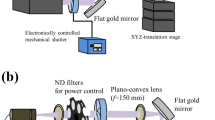Abstract.
The Er:YAG and the CO2 laser are competitors in the field of hard tissue ablation. The use of Er:YAG lasers (2.94 μm, pulse length τL of 100 to 200 μs) show smaller areas of thermal defects then ‘‘superpulsed’’ CO2 lasers with pulse lengths of approximately 100 μs. Only the development of a Q-switched CO2 laser (9.6 μm, τL=250 ns) allowed for similar results. In this paper new results for the Er:YAG and the Q-switched CO2 laser under the influence of water spray will be presented. Several parameters are of special interest for these investigations: the specific ablation energy, which shows a minimum for the CO2 laser at an energy density of 9 J/cm 2 and a broad shallow minimum in the range of 10 to 70 J/cm2 for the Er:YAG laser, and comparison of the cut-shape and depth. Surface effects and cutting velocity are discussed based on SEM pictures.
Similar content being viewed by others
Author information
Authors and Affiliations
Additional information
Received: 19 July 2000 / Revised version: 1 November 2000 / Published online: 30 November 2000
Rights and permissions
About this article
Cite this article
Stanislawki, M., Meister, J., Mitra, T. et al. Hard tissue ablation with a free running Er:YAG and a Q-switched CO2 laser: a comparative study . Appl Phys B 72, 115–120 (2001). https://doi.org/10.1007/s003400000517
Published:
Issue Date:
DOI: https://doi.org/10.1007/s003400000517




